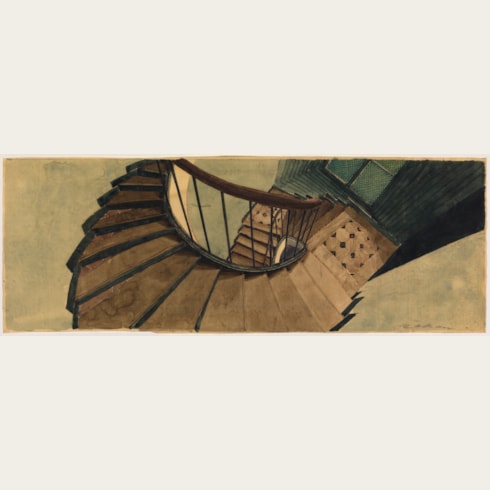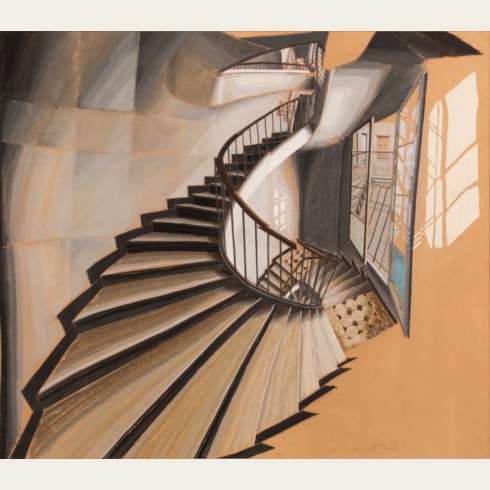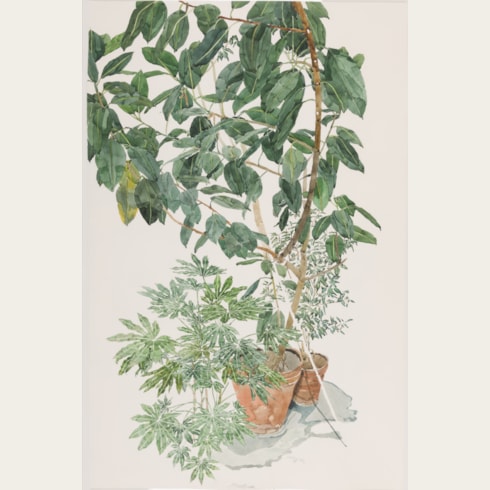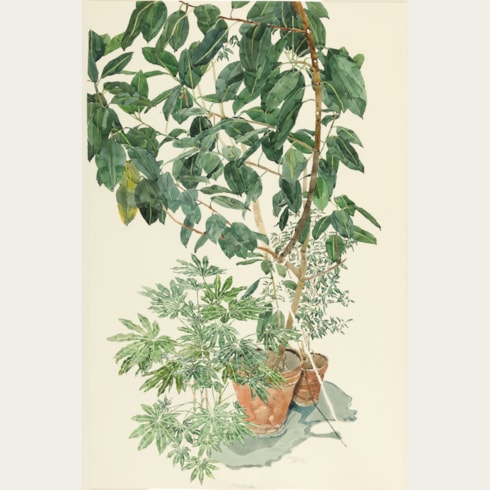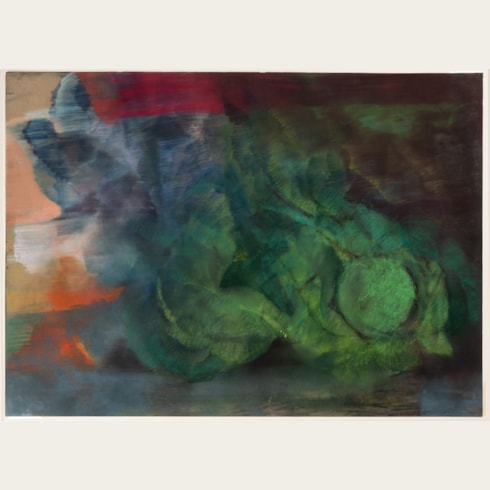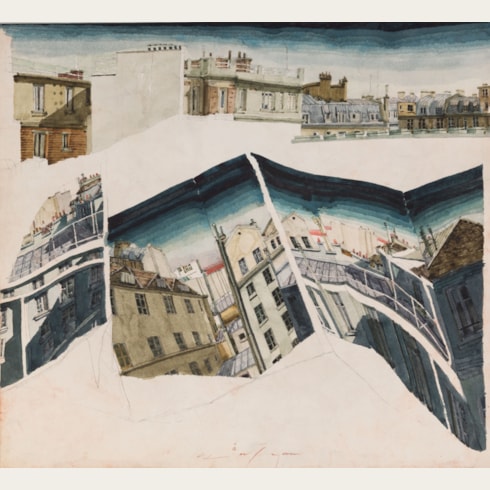Sam SZAFRAN
(Paris 1934 - Paris 2019)
Staircase
Sold
Pastel on card.
Signed Szafran at the lower centre.
284 x 190 mm. (11 1/8 x 7 1/2 in.)
Signed Szafran at the lower centre.
284 x 190 mm. (11 1/8 x 7 1/2 in.)
‘If I had known what I was letting myself in for, admits Szafran, I probably would never have bought my first box of pastels. I found myself, in 1958, fresh from abstract art, in front of these little multicolored sticks like a poverty-stricken child in a Belgian or Swiss delicatessen amidst an abundance of candy and cakes, and I seized them without even thinking. For twenty years I threw myself into this technique, because I was incapable of mastering it.’ (Gilles Néret, ‘Szafran ou la passion du pastel’, Connaissance des Arts, March 1980, p.92).
Drawn in 1980, the present sheet depicts one of Szafran’s favourite subjects; a staircase seen from above in steep perspectival foreshortening. The artist himself has noted that ‘The impression of the void, of vertigo, is the strongest sensation I have ever experienced. This can explain why my drawings always contain a hint of vertigo and that often, in front of my subject, I’m terrified by the calling of the void.’
A closely related drawing, of smaller dimensions, was one of several works by Szafran in the collection of Jacques and Anne Kerchache and was sold at auction in Paris in 2010. A much larger pastel of the same staircase, dating from 1981, is in the collection of the Musée national d’Art moderne at the Centre Georges Pompidou in Paris.
Drawn in 1980, the present sheet depicts one of Szafran’s favourite subjects; a staircase seen from above in steep perspectival foreshortening. The artist himself has noted that ‘The impression of the void, of vertigo, is the strongest sensation I have ever experienced. This can explain why my drawings always contain a hint of vertigo and that often, in front of my subject, I’m terrified by the calling of the void.’
A closely related drawing, of smaller dimensions, was one of several works by Szafran in the collection of Jacques and Anne Kerchache and was sold at auction in Paris in 2010. A much larger pastel of the same staircase, dating from 1981, is in the collection of the Musée national d’Art moderne at the Centre Georges Pompidou in Paris.
Born Samuel Berger in 1934 to Polish Jewish immigrants and raised in the area of Les Halles in Paris, Sam Szafran was imprisoned as a child at the Drancy internment camp, northeast of the city, during the Occupation. Following the Liberation he lived for some years with his mother and sister in Australia before returning to Paris in 1951, at the age of seventeen. He attended evening drawing classes and became friendly with a number of artists, including Jean Arp, Henri Cartier-Bresson, Yves Klein, Joan Miro and Jean-Paul Riopelle, as well as Alberto Giacometti. Although he was briefly enrolled at the Académie de la Grande-Chaumière in Paris in the mid-1950s, Szafran was largely self-taught as an artist. He took the maiden name of his mother when he began to sign his works, and exhibited at the Salon des Indépendants in 1957 and the Salon des Réalités Nouvelles two years later. While his earliest works were based in abstraction, from around 1960 onwards he began to depict representational subjects, drawn in pastel or charcoal and, from the late 1970s onwards, watercolour. Content with studying a limited range of themes - notably studio interiors, staircases and plant forms - he produced numerous drawings, each characterized by a very skillful handling of the medium and an abiding interest in perspectival effects. From 1965, when Szafran had his first solo exhibition, his work was exhibited extensively in France, and also in Switzerland, but only rarely elsewhere. Szafran contributed to the Nouvelle Subjectivité exhibitions curated by Jean Clair in Paris in 1976 and in Brussels in 1979. Throughout much of the artist’s career, his work was acquired by a coterie of enthusiastic and devoted collectors.
A retrospective exhibition of drawings, pastels, watercolours and sculptures by Szafran was held at the Fondation Pierre Gianadda in Martigny and the Fondation Maeght in Saint-Paul de Vence in 1999-2000. Later exhibitions followed at the Max Ernst Museum in Brühl in 2010-2011 and at the Fondation Gianadda in 2013. Following Szafran’s death in 2019, a large commemorative exhibition at the Musée de l’Orangerie in Paris in 2022-2023 drew some 330,000 visitors. In 2015 a permanent gallery devoted to Szafran’s work was established at the Fondation Gianadda in Martigny in Switzerland, while other works by the artist are today in the collections of the Metropolitan Museum of Art and the Museum of Modern Art in New York, the Centre National d’Art Contemporain, the Musée d’Orsay and the Musée d’Art Moderne in Paris, the Hirshhorn Museum and Sculpture Garden in Washington, D.C., the Musée Cantini in Marseille, and elsewhere.
A retrospective exhibition of drawings, pastels, watercolours and sculptures by Szafran was held at the Fondation Pierre Gianadda in Martigny and the Fondation Maeght in Saint-Paul de Vence in 1999-2000. Later exhibitions followed at the Max Ernst Museum in Brühl in 2010-2011 and at the Fondation Gianadda in 2013. Following Szafran’s death in 2019, a large commemorative exhibition at the Musée de l’Orangerie in Paris in 2022-2023 drew some 330,000 visitors. In 2015 a permanent gallery devoted to Szafran’s work was established at the Fondation Gianadda in Martigny in Switzerland, while other works by the artist are today in the collections of the Metropolitan Museum of Art and the Museum of Modern Art in New York, the Centre National d’Art Contemporain, the Musée d’Orsay and the Musée d’Art Moderne in Paris, the Hirshhorn Museum and Sculpture Garden in Washington, D.C., the Musée Cantini in Marseille, and elsewhere.
Provenance
Anonymous sale, Paris, Hôtel Drouot, 4 July 2000, lot 68
Galerie Nathalie Seroussi, Paris
Private collection, Paris, until 2012.





